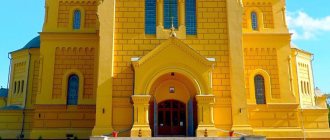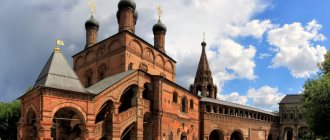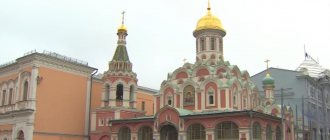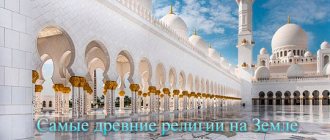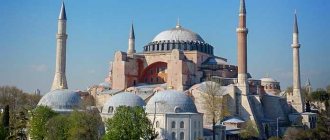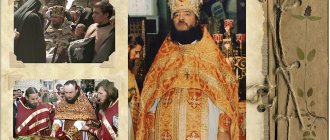Temple at the Nizhne-Arkhyz settlement (Northern) in the Republic of Karachay-Cherkessia
The stone temple near Nizhny Arkhyz in Karachay-Cherkessia arose in the 10th century, possibly even before the Baptism of Rus. The capital of the ancient state of Alanya was located in these places - the inhabitants of this city converted to Christianity in 916.
The walls of the temple are built of sandstone, and the roof is lined with thin stone slabs. Under them there was a layer of birch bark - such a technique was not found in any temple in the North Caucasus. Inside, the architects built the only baptismal font in Alanya at that time, and a cemetery appeared behind the temple. The church was dedicated to Saint Nicholas, the heavenly patron of Nicholas the Mystic, who was then the Patriarch of Constantinople.
Throughout its history, the building has never been rebuilt; now it looks the same as it did 10 centuries ago. On the rocks near the temple you can see the face of Jesus Christ written directly on the stones.
Nowadays the temple is empty. Divine services are held here only once a year - on May 6, on the day of remembrance of St. George the Victorious, the most revered saint in the Caucasus.
Read more about the temple at the Nizhne-Arkhyz settlement (Northern) in the Republic of Karachay-Cherkessia.
Monastery of St. Anthony, Suez Province, Egypt - 356 AD. e.
The Monastery of Saint Anthony stands in an oasis in the Eastern Desert of Egypt. It was built in 356 and is an active monastery to this day, home to more than 100 monks. The monks living here still follow the traditions established by St. Anthony, St. Paul and their first followers 16 centuries ago.
The church, which is the oldest part of the monastery, was built over the tomb of St. Anthony. Visitors to the monastery, often called pilgrims, can take monastic tours of its ancient halls and buildings and view the collection of medieval Coptic wall paintings that adorn the wall above the saint's tomb.
Church of St. John the Baptist in Kerch
The exact date of construction of the temple is unknown. Researchers believe that it was erected in the 10th century, and elements of an even more ancient cult building of the 6th century were used in its construction. These include Byzantine baked brick, carved blue-veined Greek marble columns and stone ceilings. Amphoras from the 8th century were discovered in the walls; they served as vocalists - they amplified sound and eliminated echo.
In the 13th–15th centuries, when Kerch became a Genoese colony, Italian frescoes appeared in the temple. Some of them perished during the Crimean Khanate: the authorities gave the building to a mosque, and the workers scraped and smeared the faces of the saints.
Construction of the temple began in the 19th century. In 1801, the western aisle was erected, and in 1845, a two-tier bell tower and a northern vestibule in the neo-Byzantine style. When they dug the foundation, they discovered funeral steles from the 5th century BC. e. The stones were built into the southern wall of the temple.
During Soviet times, the temple housed the Kerch Lapidarium, a collection of archaeological finds from ancient times. And today, services are held here again.
Read more about the Church of St. John the Baptist in Kerch.
Church of Megiddo, Tel Megiddo, Israel - late 3rd - early 4th century AD. e.
The most interesting discovery story concerns the Church of Megiddo, located in Israel. The remains of a church were found on the site of a modern prison, and prisoners were the first to discover clues at the archaeological site in 2005.
Tel Aviv University archaeologists then conducted further excavations and collected remarkable information about this ancient church.
The founding of the Megiddo church dates back to the 3rd century, decades before Christianity was institutionalized in the area. A huge mosaic with an area of almost 55 square meters. m. is the most interesting feature of this place. An inscription inside the church mentions a Roman officer named Gaianus, who donated "his money" to make the mosaic.
Cathedral of Sophia of the Wisdom of God in Novgorod
The St. Sophia Cathedral in Veliky Novgorod was founded by Prince Yaroslav the Wise on the site of the 13-domed temple in 989. It was consecrated by the first Russian bishop Luka Zhidyata in 1050.
The cathedral was built according to the type common in Ancient Rus' - cross-domed. The outline of its base resembled a cross, and the interior space consisted of a main volume under the dome and four galleries on different sides.
The inside of the temple was finished already in the next century. It was decorated in the manner of Byzantine cathedrals, only instead of marble and mosaics, plaster and frescoes were applied to the walls. At the end of the 12th century, bronze gates were installed in the cathedral, which were created by German craftsmen in Magdeburg. The doors were decorated with bas-reliefs based on scenes from the Old and New Testaments.
The cathedral preserves fragments of frescoes from the 12th century: images of prophets and angels on the arches of the main dome and wall faces of Saints Constantine and Helen. In the temple you can also see the royal prayer place, which was installed by order of Ivan the Terrible, and the chandelier - the main candelabra. It was presented to the cathedral by Boris Godunov.
Read more about the Cathedral of Sophia of the Wisdom of God in Novgorod.
Trier Cathedral, Trier, Germany – 340 AD. e.
Trier Cathedral is the oldest church in Germany and also the oldest building that still serves its original purpose as a cathedral. But what makes Trier Cathedral truly fascinating are its relics.
It contains one of the Holy Nails that is said to have held Jesus on the cross, as well as an artifact known as the Seamless Robe of Jesus. This robe, worn by Jesus shortly before his crucifixion, is kept in an annex to the chapel and is shown to the public only on rare occasions. He last exhibited in 2012.
Temple in the name of the Holy Apostles Peter and Paul in Smolensk (Peter and Paul Church)
Peter and Paul Church is the oldest in Smolensk. It was built in 1146 under Prince Rostislav Mstislavich, the grandson of Vladimir Monomakh. The inside of the temple was painted with frescoes with floral patterns. Later, the brick floor was covered with majolica tiles, and the walls were decorated with tiles and panels.
During the Time of Troubles, Smolensk was occupied by the Poles, and Catholic services were held in the Peter and Paul Church. It was then that the western extension appeared - the residence of the Polish bishop. The temple was returned to Orthodox parishioners in 1654, when the Poles left the city. The diocese erected a tented bell tower near the western wall.
In the 17th–18th centuries, the third floor was built in the temple, the main nave was expanded and the floor was raised to the level of the first floor of the extension. The church acquired its original appearance only in the middle of the last century.
Today in the Peter and Paul Church you can see fragments of medieval frescoes, ancient colored tiles, as well as rare graffiti - inscriptions from the 12th century.
Read more about the temple in the name of the Holy Apostles Peter and Paul in Smolensk (Peter and Paul Church).
Church of Boris and Gleb in the village of Kideksha
The Boris and Gleb Church in the village of Kideksha not far from Suzdal appeared during the time of Yuri Dolgoruky, in 1152. This is one of the first white stone buildings in North-Eastern Rus'.
Building a church in those days was almost as difficult as the Egyptian pyramids. The material was mined near Moscow, 500 km from these places, and transported along rivers and land. Workers trimmed cobblestones and laid them with virtually no mortar.
The appearance of the church combined features of Russian medieval architecture and Western Romanesque style: a traditional cubic base, an unusually designed portal and arcature - rows of decorative false arches on the walls. Throughout history, the temple was restored more than once, and in the 17th century the dome was replaced.
At the end of the twentieth century, the Boris and Gleb Church was included in the UNESCO World Heritage List. Nowadays, the temple is not in use; frescoes from the 12th century are being studied here and excavations are taking place. Under the modern floor, researchers discovered the original base of the iconostasis and omphalia - a place for the bishop - made of rare pink stone. Omphalius of the Boris and Gleb Church is the oldest in Russia.
Read more about the Church of Boris and Gleb in the village of Kideksha.
Cathedral of the Assumption of the Blessed Virgin Mary in Vladimir
The white stone Assumption Cathedral was erected in 1160 by Grand Duke Andrei Bogolyubsky. The domes were covered with gilded copper sheets with prayer inscriptions, and the building itself was decorated with frescoes.
In 1185, after a fire, the temple was rebuilt by Prince Vsevolod the Big Nest. He added side galleries, and the old structure was inside the new one. The walls of the original cathedral were partially dismantled, leaving only the supports of the vaults.
In the 13th century, the cathedral suffered another fire - it was burned by the Mongol-Tatars. The temple was restored again, but painted much later, at the beginning of the 15th century. Andrei Rublev and Daniil Cherny came here for this purpose.
Throughout history, the temple was renovated and completed several times. The Baroque iconostasis, which can be seen in the cathedral today, was installed during restoration in the 18th century, at which time the four-tier bell tower appeared. Most of the Rublev frescoes were covered with plaster. Fragments of the composition “The Last Judgment” on the western wall and part of the frescoes in the altar room have survived to this day.
Today the cathedral is included in the UNESCO World Heritage List.
Source
Spaso-Preobrazhensky Cathedral of the Mirozh Monastery
The Transfiguration Cathedral was erected on the banks of the Velikaya River in Pskov by order of the Novgorod Archbishop Nifont. It was not possible to establish the exact date of construction, but it is known that in 1156 the temple already existed.
The building was built practically without a foundation; in some places the architects did not even bother to remove the top layer of soil and grass. The fact is that the coast is made of sandstone - a very mobile material that expands greatly in winter. The foundation could crack over time. Instead, the builders poured rubble stone, and strengthened the walls with a special mortar with lime. Therefore, the building did not collapse, despite the processes in the soil.
The temple was painted in the 30s of the 12th century by Greek masters. The frescoes were made with mineral paints and are similar to Byzantine icons. In the 17th century, the images were covered with plaster and whitewashed. By chance, this helped save about 80% of the drawings. Today, the paintings of the Transfiguration Cathedral are the most complete monument of medieval fresco painting in Russia.
Read more about the Transfiguration Cathedral of the Mirozh Monastery.
St. Peter's Basilica, Vatican City, Italy – 326–360. n. e.
St. Peter's Basilica is probably the most famous church on this list. Originally commissioned by Roman Emperor Constantine I in 326 AD. e. St. Peter's Basilica is considered one of the most famous works of Renaissance architecture and the largest church in the Vatican City, the papal enclave in Rome.
Catholic tradition holds that St. Peter, one of Jesus' apostles and the first Bishop of Rome (the Pope), is buried in this basilica. St. Peter's tomb is supposedly located directly under the high altar, and for this reason many Popes have been buried in the basilica since the early Christian period. Not only is it an important place of worship, but it is also home to many artistic masterpieces by great masters such as Michelangelo and Giovanni Lorenzo Bernini, among others. It's no wonder that 10 million people visit this magnificent church every year.
